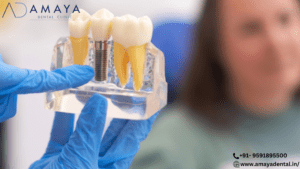Are you facing the daunting prospect of a root canal treatment? Don’t worry, we’re here to guide you through every step of the process.
Let’s delve into what you need to know: from understanding the treatment and procedure to recognizing symptoms and discovering how it can relieve your tooth pain while preserving your precious smile. Stick with us as we break down each aspect, ensuring you’re fully informed and prepared for your journey to dental health and happiness.
What is a Root Canal?
Deep within our teeth lies a vital core known as the dental pulp, comprised of various tissues essential for tooth health. When decay breaches this core, it can lead to inflammation or infection, sometimes resulting in the pulp’s demise. To salvage the tooth and eradicate the decay, a root canal becomes necessary.
A root canal treatment involves the meticulous removal of bacteria from the infected root canal, preventing further spread of infection. Once the infected pulp is eliminated, the tooth’s interior is thoroughly disinfected and cleansed before sealing the space with a filling, thus preserving the natural tooth structure.
But how do you recognize the need for a root canal? How can you tell if the pulp is infected? Let’s delve into the telltale signs that may indicate the necessity of a root canal procedure.
Symptoms that indicate a need for root canal treatment
The most reliable technique to determine whether you require root canal therapy is to visit your dentist. However, keep an eye out for these warning signs since the earlier you identify them, the sooner your tooth can be treated and preserved.
The following are the symptoms:
- Persistent tooth pain
- Sensitivity to hot and cold food
- Tooth discoloration
- Swollen gums
- Pain when you touch the tooth
- A chipped or cracked tooth
- Tooth feels loose
- Pimples on the gums
- Severe pain while chewing or biting
Your dentist will examine the tooth and take X-rays to confirm the diagnosis.

Having a root canal procedure is typically performed by either the best dentist in Bangalore or an endodontist, a specialist dedicated to treating dental pulp-related issues. If your case is complex, your dentist may refer you to an endodontist for specialized care.
- First, an X-ray is taken to assess the tooth’s condition and surrounding bone for signs of infection. Local anesthesia is then administered to numb the area, ensuring you feel no pain during the procedure while remaining awake.
- To keep the treatment area dry and free of saliva, a rubber dam is placed around the tooth.
- Once numb, a small opening is made at the top of the tooth, known as the crown, using a drill or LASER (Light Amplification by Stimulated Emission of Radiation).
- Special dental tools called files are used to carefully remove the damaged pulp and bacteria, while simultaneously cleaning and shaping the root canal. Throughout the process, sodium hypochlorite or water is sprayed to flush away debris.
- After thorough cleaning, the root canals are filled with a biocompatible material called gutta-percha. To ensure complete sealing, gutta-percha is combined with adhesive cement.
- Finally, a filling is placed at the initial opening to seal the tooth. Your dentist or endodontist will then discuss any further restoration needed, such as placing a crown or other protective measures to safeguard the tooth from future damage. Early detection and treatment are vital for preserving your tooth’s health and maintaining a beautiful smile.
Is Root Canal a painful treatment?
Experiencing mild discomfort after a root canal treatment is common due to the extensive cleaning involved. This procedure deeply cleans the tooth’s canals, which can temporarily irritate surrounding nerves and gums until the area heals completely. However, this discomfort typically subsides with time.
To manage any post-procedure discomfort, your dentist may recommend over-the-counter pain medications for relief. However, if you notice persistent or severe pain beyond what is expected, it’s important to promptly inform your dentist.
For a painless root canal treatment experience in Bangalore, consider consulting Amaya Dental Clinic. Their expert team is dedicated to providing gentle and effective dental care to ensure your comfort throughout the process.
What happens after a root canal?
After undergoing a root canal procedure, it’s normal for the tooth to feel sensitive for the first few days due to inflammation of the surrounding tissues. However, this sensitivity typically subsides within a few hours or up to two days.
The duration of the results largely depends on how well you care for your teeth post-treatment. Here are some essential steps to follow after a root canal:
- Avoid chewing on the treated tooth immediately after the procedure to allow it time to heal.
- Maintain regular oral hygiene practices, including brushing, flossing, and using mouthwash, to keep the area clean and prevent infection.
- Attend all follow-up appointments with your dentist as scheduled to monitor the healing process and address any concerns promptly.
By following these guidelines and staying proactive with your dental care, you can ensure the success of your root canal treatment and maintain optimal oral health.
In conclusion, while a root canal treatment may involve some temporary discomfort and anxiety, it ultimately offers long-term relief from dental pain and discomfort. If you’re experiencing any symptoms suggestive of needing a root canal, we encourage you to seek prompt evaluation from your dentist. At Amaya Dental Clinic, we offer comprehensive dental services, ranging from routine check-ups to advanced surgical procedures. If you’re in need of root canal treatment in Bangalore, we’re here to help. Schedule an appointment with us today to receive expert care and personalized attention for your dental needs.


